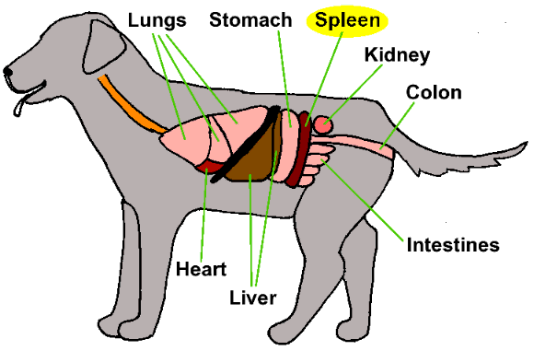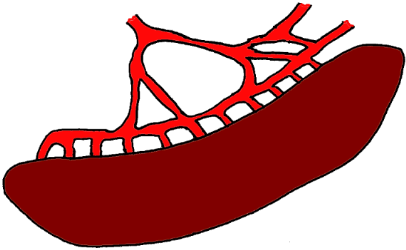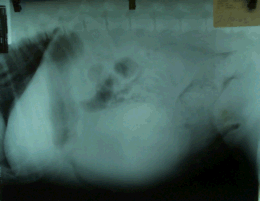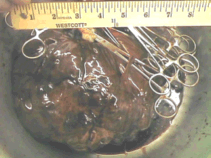|
SPLENECTOMY


(original graphic by marvistavet.com)
WHAT IS THE SPLEEN FOR?
The spleen is an oblong organ (some would say it is tongue-shaped) seated just below the stomach. Its consistency is similar to that of the liver. While one can live perfectly well without a spleen, the spleen does provide some helpful services to the body.
 (original graphic by marvistavet.com) (original graphic by marvistavet.com)
- NATURE'S BLOOD BANK
The spleen contains lots of long winding narrow blood vessels full of hair-pin turns for circulating red blood cells to make. This means that there are a lot of red blood cells working their way gradually through the spleen at any given time effectively making the spleen a storage area for blood. If one has a severe hemorrhage and needs extra blood, the involuntary muscles of the spleen contract, squirting forth a fresh supply of blood. The spleen provides nature’s blood transfusion, if you will.
- REMOVING OLD BRITTLE RED BLOOD CELLS
Older red blood cells become more brittle than their younger counterparts. As they attempt the tortuous route through the spleen, many older red cells do not make it out the other side. These cells rupture trying to make the tight turns and their iron is captured and recycled by the spleen. The spleen thus helps remove old red blood cells from the circulation, sort of a clean-up function.
- REMOVING INFECTED RED BLOOD CELLS
The spleen also performs a function called “pitting” where it is able to bite off sections of the red blood cells passing through. The areas of the red blood cell that the spleen has designated for it to bite off or “pit” have been marked by the immune system. In this way the spleen can remove red blood cell parasites from the circulating red blood cells, helping keep cells functioning that otherwise might become irreparably damaged if their infection is allowed to persist. Sometimes entire red cells are removed from the circulation in this way thus preventing the spread of the red cell parasite inside. This sounds like a good thing but it can get out of hand. For example, in Feline Infectious Anemia, the spleen commonly removes so many red blood cell portions that the infection is difficult to detect plus the patient becomes dangerously anemic (not from the actual parasite but from the spleen removing large numbers of infected red blood cells). In severe cases of this condition, the spleen may have to be removed.
- PART OF THE LYMPHATIC SYSTEM
The above functions take place in what is called the “red pulp” of the spleen. The spleen also contains what is called “white pulp.” The white pulp is essentially part of the lymphatic system, sort of like a lymph node. It serves the same functions as a lymph node but is connected through the circulatory system. Lymph nodes are centers of activity for the immune system, especially antibody producing lymphocytes. Material from the local area of the body drains to the lymph node via the lymph vessels and the lymphocytes may or may not become stimulated into reacting depending on what sort of material is present. A reactive lymph node enlarges (the obvious example is the submandibular nodes that swell when one has a sore throat). The white pulp of the spleen sees material from the circulatory system rather than material from the local lymphatics. Lymphocytes circulate through the splenic white pulp just as they do through the lymphatic vessels, carrying messages involved in the war against body invaders (bacteria, viruses etc.)
WHY MIGHT THE SPLEEN NEED TO BE REMOVED?
There are several reasons why the spleen might need to come out. In dogs, by far the main reason is a growth or mass on the spleen which has broken open and started bleeding and much of the discussion below regards this scenario. Other reasons to remove the spleen involve curtailing the pitting function reviewed above. In immune-mediated anemia, the spleen is removing too many red blood cells and the patient is suffering for it. Usually medication is used to suppress the immune-system but sometimes this is inadequate and the spleen must come out. Similarly, animals being considered as blood donors sometimes have their spleens removed to curtail the pitting function and facilitate the detection of blood parasites that might preclude use as a blood donor.
Additional reasons to remove the spleen include infiltration by cancer. In particular, there is a form of mast cell cancer in cats which is largely limited to the spleen and removing the spleen can be provide a long remission or even cure. Sometimes the spleen is ruptured in a trauma and must be removed to control the bleeding. For the most part, spleens are removed because they have grown a mass which has started to bleed so our discussion will begin here.
SPLENIC MASSES – WHY ARE THEY BAD?
Most spleens are removed because they have grown a tumor. Tumors can be benign (like the red pulp hemangioma) or malignant (like the red pulp hemangiosarcoma, white pulp mast cell tumors, or white pulp lymphosarcoma). In dogs, most splenic masses are either hemangiomas or hemangiosarcomas while in the cat they are usually either mast cell tumors or lymphosarcomas.
HEMANGIOMA AND HEMANGIOSARCOMA: THE MOST COMMON CANINE SPLENIC TUMORS
Both these tumors arise from the blood vessels of the red pulp and amount to a bunch of wildly proliferating abnormal blood vessels. Eventually the growth ruptures and the spleen bleeds. When a vascular organ like the spleen bleeds, a life-threatening blood loss can result.
- Usually the patient is suddenly weak.
- The patient may be obviously cold.
- If one looks at the color of the gums, the patient will be pale in color.
- If the bleed stops on its own before it has gone too far, the patient may be dramatically better the next day or even a few hours later.
Unfortunately, the splenic mass is certain to bleed again and if the spleen is not removed, eventually the patient will bleed to death.
If the splenic tumor is benign, removing the spleen is curative provided that the patient has not lost too much blood to survive the surgery. Ideally, the splenic mass is detected before it has ever bled and the spleen is removed at a time when the mass is not actively bleeding. Of course, if the splenic mass IS actively bleeding and cannot be stopped with pressure wraps, removing the spleen becomes an emergency surgery; it is not appropriate to try to wait until the bleeding has stopped. Expect blood transfusions to be necessary before, during, and possibly after surgery.
If the splenic tumor is a malignant hemangiosarcoma, the spleen can still be removed to control the bleeding but the problem is that hemangiosarcoma is an aggressive cancer. With the removal of the spleen and primary tumor, the patient is probably spared death by bleeding to death only to eventually succumb to cancer. Since the decision to go to surgery often hinges on whether or not the tumor is malignant, some effort should be made to make this determination if delaying the surgery can be safely done. Chest radiographs and abdominal ultrasound are performed to look for evidence of tumor spread.
If there is evidence of tumor spread: this means the tumor is malignant and best control will entail both removal of the spleen and chemotherapy follow up. Many people opt for euthanasia at this point though newer drugs have held promise. Please see the hemangiosarcoma page for more details.
If there is no evidence of tumor spread: it may be possible to effect a permanent cure by removing the spleen though lack of visible tumor spread does not mean the tumor is benign. An actual piece of spleen tissue for biopsy will be needed to settle the question of malignancy.
HOW DO WE DETECT SPLENIC MASSES?

Radiograph showing an enlarged spleen (circled).
(original graphic by marvistavet.com)
There are several ways to detect a splenic mass. The first way, is by physical examination. A large firm mass in the area of the spleen may be palpable during a routine physical examination. From there, radiographs are taken of the belly to see if the mass appears to be on the spleen and radiographs of the chest are taken to see if there is evidence of cancer spread there. Based on these findings (plus basic blood work) a decision for or against spleen removal can be made. Unfortunately, many large dogs are simply too well muscled for splenic masses to be detected in this way.
Another method of detecting a splenic tumor comes on the basic blood panel. An unexplained “responsive anemia” is discovered. A responsive anemia is one typical of bleeding (as opposed to an anemia of chronic disease where red blood cells simply are inadequately produced.) An older large breed dog with an unexplained bleed is highly suggestive of a splenic tumor. The next step would be radiographs to see if a mass is apparent followed by chest radiographs for tumor spread as above. These findings on the blood panel are especially suggestive of a splenic mass if there has been a history of sudden weakness or collapse typical of a recent bleed. Splenic tumors tend to bleed intermittently (and usually insignificantly) prior to a large bleed that produced obvious symptoms. These smaller bleeds are generally enough to alter the blood panel. If blood work is suggestive of a splenic mass, radiographs can be taken to confirm the presence of the mass.
It can be difficult to determine from the radiograph if the mass is coming from the liver or from the spleen.
IF YOU CHOOSE NOT TO REMOVE THE SPLEEN
|
Unfortunately, eventually the dog will have a bleed from which he cannot recover. If you think your dog is having a bleed at home, you can apply an ace bandage around the belly in a snug manner to essentially apply pressure to the bleed. This is surprisingly effective and may stave off the inevitable temporarily or until you can get your dog to an emergency hospital for more definitive support such as a blood transfusion. There is a Chinese herb called Yunnan Baiyo which can assist in blood clotting and may be helpful in minimizing the severity of future bleeds.
Chemotherapy may still be an option even if the spleen and its malignant tumor are left behind. A newer approach to chemotherapy, called "metronomic" chemotherapy, focuses on eliminating the blood supply of the tumor rather than on killing the tumor directly. Lower doses of chemotherapy drugs are used which leads to far less potential for side effects. If this is something you are considering, it will be necessary to consult an oncologist for the most up to date information.
|
 (original graphic by marvistavet.com) (original graphic by marvistavet.com) |
OTHER REASONS TO REMOVE THE SPLEEN
We have already mentioned the splenic mass as well as excessive red blood cell removal by the spleen as reasons for splenectomy. There are some other situations where splenectomy may be needed:
- BLOAT (GASTRIC DILATATION AND VOLVULUS)
In this condition, the stomach bloats with gas and twists on its axis effectively cutting off its circulation. This is a huge emergency usually requiring surgery. The issue with the spleen is that the spleen rides just below the stomach so that when the stomach twists, the spleen twists along with it. Frequently the spleen must be removed or partly removed.
- TRAUMATIC RUPTURE OF THE SPLEEN
If the patient suffers blunt trauma to the abdomen such as getting kicked by livestock or being hit by a car, the spleen may rupture and dangerously bleed. If a tear in the spleen is small, it may be repaired (sewn together) but if the rupture is severe, it may be easiest to simply remove the whole spleen.
SPLENECTOMY
|
When a dog with a splenic mass is going to have its spleen removed (“splenectomy”) there are some issues to understand.
- The spleen may begin bleeding at any time up until it is actually removed. If this occurs, blood transfusion is likely going to be needed (either with artificial blood or whole blood, depending on what is available). It is possible that multiple transfusions will be needed. A parameter called the “PCV” (“packed cell volume”) will be monitored to make sure the amount of circulating red blood cells does not fall dangerously low. If one is lucky, the spleen will not be bleeding at any time during surgery. Some patients must receive blood transfusions prior to splenectomy to insure they have a reserve of red blood cells in case of surgical bleeding.
THE MOST COMMON COMPLICATION OF SPLENECTOMY IS HEMORRHAGE (BLEEDING).
The spleen is supplied by numerous blood vessels which must
be ligated or sealed in order for the spleen to be removed.
Be prepared for blood transfusion(s) to be needed.
|
 (original graphic by marvistavet.com) (original graphic by marvistavet.com) |
- It may not be known prior to surgery if the tumor is benign or malignant, particularly if there was no time to have an ultrasound exam before surgery. There is a fair chance that malignancy will be immediately obvious once the belly is opened. If the tumor is obviously malignant, will you want your dog euthanized at that point? Will you want the spleen removed so that you can consider chemotherapy? Will you want the incision simply closed and your dog awakened? These questions should be answered prior to surgery so that your veterinarian will know what to do should this situation arise.
- The dog having a splenectomy because of a splenic mass will appear substantially thinner after surgery. There will be a very long incision to accommodate this very large organ and perhaps a bandage to control any leaking of blood from the incision.
- Most dogs go home a day or two after surgery. An iron supplement may be needed to help the body recover from any blood loss. Antibiotics will likely be prescribed as will some sort of analgesia (pain relief) for the recovery period.
|

The spleen and its large
blood clots are likely to
weigh 5-10 lbs. in a large dog.
(original graphic by marvistavet.com)
|

Page last updated: 1/23/2021
Page last reviewed: 10/27/2021
|